
* While Canada is not generally perceived as a center of the aircraft industry, in reality the country became a prominent player in commercial aircraft through the Bombardier Group. One of the major components of Bombardier's product line is the family of business jets and light airliners established by the group's Canadair component -- including the Canadair Challenger and its derivatives, the Global Express, and jetliners like the Canadair Regional Jet (CRJ). This document provides a history and description of Bombardier's business jets and airliners. A list of illustration credits is included at the end.
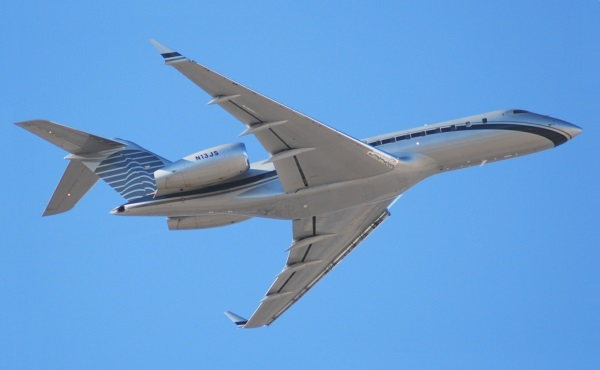
* What would become the Canadair Challenger was designed by Bill Lear of Learjet fame in the mid-1970s. Lear had sold off his aircraft production facility to the Gates Rubber Company to focus on design through his Lear Avia company, and began to peddle his "LearStar 600" concept to various aviation firms. Canadair bought rights to the proposal in 1976, but insisted on a wider fuselage -- 2.74 meters (108 inches): marketing studies had shown customers wanted to have "stand up" room in a business aircraft.
Lear objected, feeling with legitimate reason that it would degrade the lines of the aircraft, calling the Canadair modification "Fat Albert". Canadair management compromised, inviting Lear to submit his own derivative design with a wider fuselage -- but to no great surprise, in the end Canadair preferred their own derivative over Lear's "Allegro". Lear, however, did prove influential in helping to convince the Canadian government to back Bombardier's effort to build a business jet.
Canadair's push for a widebody business jet would prove justified over the long run. Business jets to that time had been cramped, and the roominess provided by the expanded fuselage more than compensated for its fat lines. It would also provide a strong platform for expansion.
The first of three prototypes of the initial production version, the "Challenger 600" or "CL-600", performed its initial flight on 8 November 1978, with test pilot Doug Atkins at the controls. The first prototype was later lost in a crash on 3 April 1980, three crew successfully bailing out, but the captain being killed. The type obtained certification in late 1980.
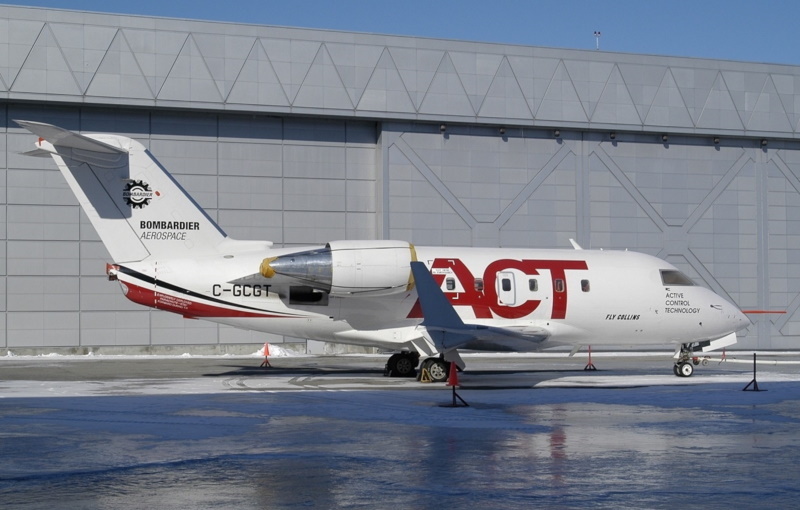
The Challenger 600 provides a baseline for description of the Challenger family. It was a business jet of generally conventional configuration, with all swept flight surfaces, including a low-mounted wing and a tee tail. It had tricycle landing gear, with all gear assemblies featuring twin wheels. The nose gear retracted forward and the main gear hinged from the wing near the wing root in towards the fuselage; incidentally, there were no covers over the main gear wheels. It was powered by twin Avco Lycoming ALF-502L turbofans, mounted on the rear of the fuselage, each engine providing 33.6 kN (3,400 kgp / 7,500 lbf) thrust. The Challenger 600 had a crew of two and could carry from 14 to 18 passengers, depending on seating arrangement.
___________________________________________________________________
CANADAIR CHALLENGER 600:
___________________________________________________________________
wingspan:
18.85 meters (61 feet 10 inches)
wing area:
41.8 sq_meters (450 sq_feet)
length:
20.85 meters (68 feet 5 inches)
height:
6.3 meters (20 feet 8 inches)
empty weight:
10,285 kilograms (22,675 pounds)
MTO weight:
18,200 kilograms (40,125 pounds)
max cruise speed:
890 KPH (550 MPH / 480 KT)
service ceiling:
13,720 meters (45,000 feet)
range:
6,300 kilometers (3,915 MI / 3,400 NMI)
___________________________________________________________________
84 Challenger 600s were delivered into 1983. Most were later upgraded with winglets to the "Challenger 600S" configuration. The Royal Canadian Air Force (RCAF) obtained a dozen Model 600s, with seven configured as "CE-144" electronic support and training aircraft; one used as a "CX-144" electronic test and trials platform; and four used as "CC-144" VIP transports. All twelve were eventually upgraded with winglets. The RCAF also obtained the use of the second prototype as a trials machine.
* The ALF-502 turbofans proved a serious weakness of the Challenger 600; they weren't powerful enough, and apparently were not all that reliable. That mean fitting new engines, in the form of General Electric (GE) CF34 turbofans, leading to the "Challenger 601" series. The 601 also introduced winglets as a standard feature of the series. Variants included:
Four Model 601s were acquired by the Canadian government as VIP transports, once again being designated "CC-144". The type was also obtained in small numbers by the German Luftwaffe, the People's Republic of China, and Malaysia.
* Canadair was acquired by the Bombardier Group in 1986; the Challenger program continued energetically under new management. The 601 series was followed by the "Challenger 604" series. The program was initiated in early 1993, with the initial flight taking place on 18 September 1994. The 604 featured:
FAA certification was awarded in late 1995, with first deliveries taking place the next year, in 1996. A few have been configured as air ambulances.
___________________________________________________________________
BOMBARDIER CHALLENGER 604:
___________________________________________________________________
wingspan:
19.61 meters (64 feet 4 inches)
wing area:
45.71 sq_meters (492 sq_feet)
length:
20.85 meters (68 feet 5 inches)
height:
6.3 meters (20 feet 8 inches)
empty weight:
9,805 kilograms (21,620 pounds)
MTO weight:
21,865 kilograms (48,200 pounds)
max cruise speed:
870 KPH (540 MPH / 470 KT)
service ceiling:
12,500 meters (41,000 feet)
take-off field length:
1,740 meters (5,700 feet)
range:
7,550 kilometers (4,690 MI / 4,080 NMI)
___________________________________________________________________
The Challenger 604 was adopted by Australia for the search and rescue (SAR) mission, with four "CL-604 SAR" machines ordered, the first entering service in 2016. These aircraft were fitted with a Selex ES Seaspray 5000E active-array radar, an infrared imager, radio direction finders, observation windows, and air-operable doors for dropping rescue kit.
Three Challenger 604s were obtained by Denmark as coastal patrol and utility aircraft, and South Korea has also obtained the type for coastal patrol. The Danish machines, which were converted to the "Multi-Mission Aircraft (MMA)" configuration by Field Aircraft, had an AN/APS-143 search radar in a fairing in the belly near the leading edge of the wing, and an electro-optic ball turret that retracted into the belly, positioned between the engines. One had an external attachment point for a side-looking radar or a weapon; all three had "quick change" interiors to allow them to be used as VIP aircraft.
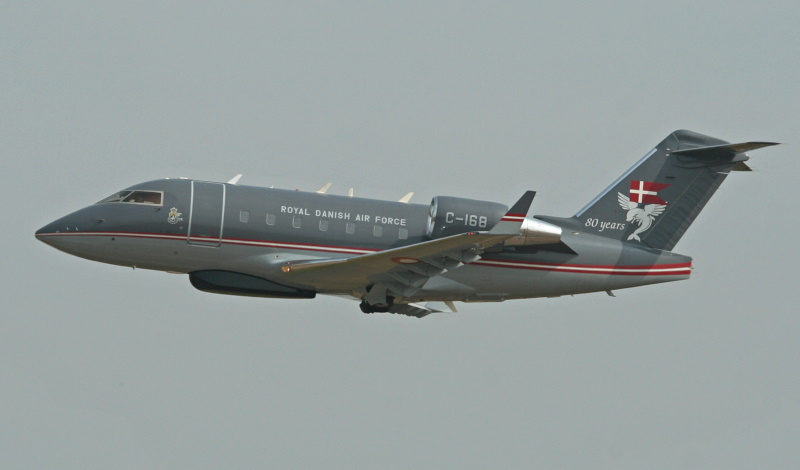
A fourth, obtained second-hand, was configured solely as a VIP aircraft. The Danish patrol machines were upgraded from 2019, with a new radar, datalink, and modernized cockpit. The configuration of the South Korean machines is unclear, though they did have a radar fairing and other protuberances suggesting sensor fits. Two air-ambulance CL-604s were obtained from a commercial operation by the Swiss Air Force. One CL-604 was also obtained by the US Coast Guard as the "C-143" -- apparently for some special-mission role, but it ended up being a VIP transport.
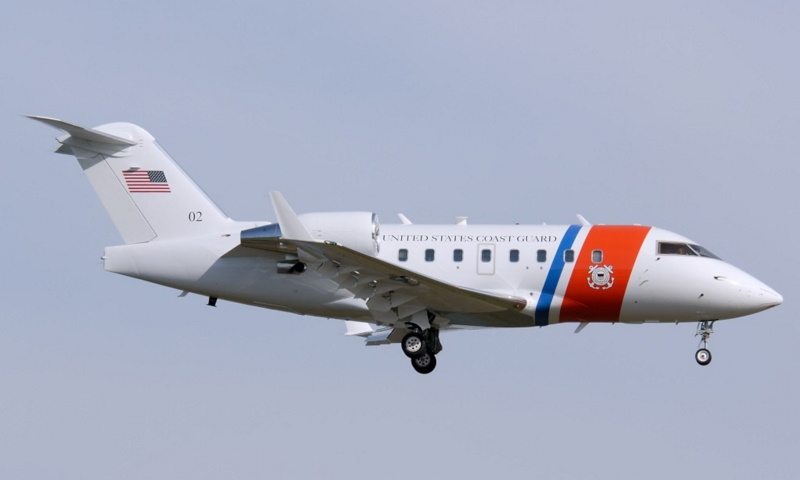
* In 2005, Bombardier began development of the "Challenger 605" -- much like the CL-604, but with a Rockwell Collins ProLine 21 avionics suite; a redesigned interior with bigger windows, shifted up the fuselage; and a tail cone instead of a boat tail. Initial flight was on 22 January 2006. It obtained certification in late 2006 and went into service in 2007.
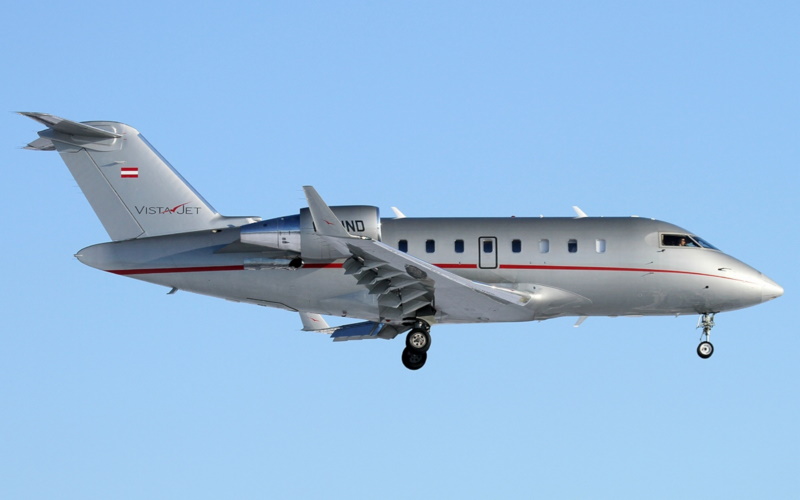
In 2013, Boeing announced the development of a "Maritime Surveillance Aircraft (MSA) based on the Challenger 605 as a relatively low-cost solution for the maritime patrol mission. Mission systems were in part derived from the Boeing 737-based P-8 Poseidon maritime patrol aircraft, most notably the Poseidon's AN/APY-10 multimode radar and its integrated software system. Boeing worked with Field Aviation for the MSA conversions, with Field obviously leveraging off the Danish MMA conversions to kit up a Challenger 604 as an MSA demonstrator, with Field flying a demonstrator from early 2014. Nothing seems to have come of the effort: the P-8 Poseidon has sold well, and there are many other offerings for low-cost MSA platforms.
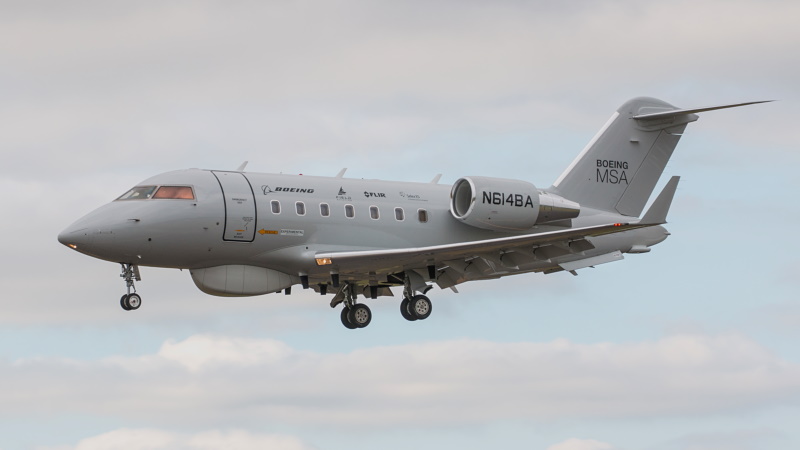
Two Challenger 605s, owned and operated by a contractor, were used by the US Army to evaluate advanced sensor systems, these machines being named the "Airborne Reconnaissance & Targeting Multi-Mission Intelligence System (ARTEMIS)". They were intended to pave the way towards a future "High Accuracy Detection & Exploitation System (HADES)" to "detect, locate, identify and track critical targets for the ground commander." Although the two Challenger 605s were not operational systems, apparently they did seem some operational use.
* The Challenger 605 was followed by the "Challenger 650", featuring a redesigned and more spacious cabin; GE CF34-3B MTO engines with 41 kN (4,180 kgp / 9,220 lbf) thrust each; and a state-of-the-art "glass cockpit" scheme named "Bombardier Vision". The Challenger 650 was announced in 2014, unveiled to the public in the spring of 2015, with shipments beginning late in that year.
The Challenger series has been a money-maker for Canadair / Bombardier, with over 1,600 sold to date. Upgrades are available for older Challengers. In 2017, Nextant Aerospace of Cleveland, Ohio, launched a cockpit upgrade program for the Challenger 604, the upgraded machines to be redesignated "Challenger 604XT". The upgrade will feature the Rockwell Collins Pro Line Fusion integrated avionics system, with three large displays and a "synthetic vision" scheme to provide effective vision at night or bad weather. It is not clear when it will be introduced.
BACK_TO_TOP* In 1995, Bombardier began studies for a business jet positioned between the Learjet and the Challenger 600 series, with a cabin mockup of what would become the "Challenger 300" or "Challenger Continental" displayed to the public at the National Business Aircraft Association (NBAA) Convention in Las Vegas in 1998. Initial flight of the prototype was on 14 August 2001 from the Bombardier Learjet plant in Wichita, Kansas, with test pilot Jim Grabman at the controls.
The second machine performed its initial flight on 9 October 2001, with Grabman and Doug May at the controls. The third aircraft performed its first flight on 7 December 2001, with the fourth -- the first with a complete interior -- following on 5 April 2002, and the fifth on 8 March 2003. Along with the five flight test machines, two static test airframes were built as well. Type certification was granted in 2003, with initial production rolled out at the same time. The Bombardier Flexjet fractional ownership program was the first user, with initial customer flight on 8 January 2004.
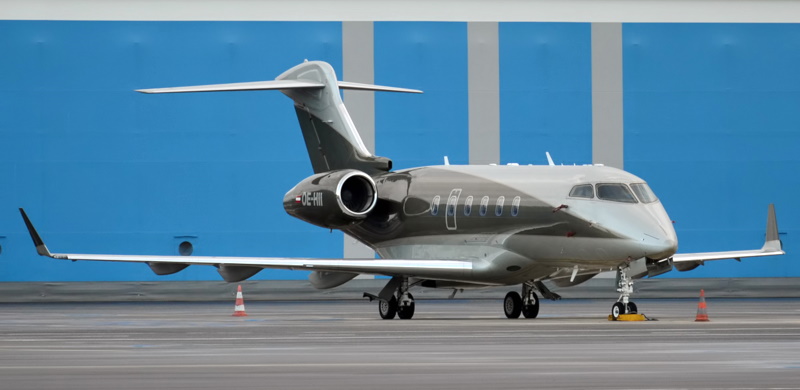
The Challenger 300 was designed to provide a transcontinental transport capability for a typical load of eight passengers, though high-density arrangements for 15 are possible as well. It was not simply a modified Challenger 604/605, instead being essentially a new aircraft, only featuring a general layout similar to that of the other Challengers -- swept flight surfaces with tee tail and winglets; twin turbofans in the rear; a downward-opening airstair door on the front left fuselage; and tricycle landing gear, all gear with twin wheels, the main gear not having wheel covers.
The Challenger 300 featured a Rockwell Collins ProLine 21 avionics suite and glass cockpit. It was powered by twin AlliedSignal (Honeywell) AS907 turbofans, with a thrust of 30.4 kN (3,095 kgp / 6,825 lbf) each and full-authority digital engine controls (FADEC).
___________________________________________________________________
BOMBARDIER CHALLENGER 300:
___________________________________________________________________
wingspan:
19.23 meters (63 feet 1 inch)
wing area:
48.5 sq_meters (522 sq_feet)
length:
20.97 meters (68 feet 10 inches)
height:
6.22 meters (20 feet 5 inches)
empty weight:
10,140 kilograms (22,350 pounds)
MTO weight:
17,010 kilograms (37,500 pounds)
max cruise speed:
870 KPH (540 MPH / 470 KT)
service ceiling:
13,715 meters (45,000 feet)
take-off field length:
1,450 meters (4,755 feet)
range:
5,740 kilometers (3,565 MI / 3,100 NMI)
___________________________________________________________________
Bombardier announced an improved variant, the "Challenger 350", in 2013, with the first performing its initial flight on 2 March of that year, and initial deliveries in 2014. It was difficult to distinguish from the Challenger 300, the primary change being Honeywell HTF7350 turbofans, providing better fuel economy, power, and range -- extended to 5,925 kilometers (3,680 miles / 3,200 NMI). It also featured reprofiled winglets and a redesigned interior. It has since been tweaked in production, for example to support "steep approach certification". Steep approach is required for access to certain restricted airports, most notably that of the City of London.
The Challenger 350 was followed in turn by the "Challenger 3500", introduced to service in 2022. It was much like the Challenger 350 externally, retaining the same engines, but with a redesigned cabin with voice-controlled LED lighting and entertainment system featuring a large-screen display. It had a modernized flight deck, GPS-INS navigation system, a synthetic vision system with an optional head-up display (HUD), plus a maintenance monitoring system that could send notifications to service crews.
BACK_TO_TOP* Following the Challenger 300, Bombardier focused on a high-end, transcontinental-range business jet, the "Global Express". The program was publicly unveiled in 1991, with the first of four flight-test prototypes performing its initial flight on 13 October 1996. Two static test prototypes were also built. The type was certified in 1998, with initial deliveries to customers by the end of that year. It was officially labeled the "Bombardier Global Express", the company having finally decided to drop the classic "Canadair" label.
The Global Express had a low wing, all swept flight surfaces, tee tail, winglets, rear-mounted twin engines, twin wheel landing gear (if with main wheel covers). It was powered by twin BMW / Rolls-Royce BR710A2-20 turbofans with FADEC and providing 66.1 kN (6,690 kgp / 14,750 lbf) thrust. The cockpit was fitted with a Honeywell Primus 2000 flight system with six displays. Flightcrew included pilot, copilot, and one or two flight attendants. The number of seats normally ranged from 8 to 18, with two lavatories plus a galley. Customized interiors were available at customer request, with a few users configuring Globals as air ambulances.
___________________________________________________________________
BOMBARDIER GLOBAL EXPRESS:
___________________________________________________________________
wingspan:
28.60 meters (94 feet )
wing area:
94.9 sq_meters (1,022 sq_feet)
length:
30.30 meters (99 feet 5 inches)
height:
7.57 meters (24 feet 10 inches)
empty weight:
22,135 kilograms (48,800 pounds)
MTO weight:
42,410 kilograms (93,500 pounds)
max cruise speed:
935 KPH (580 MPH / 505 KT)
service ceiling:
12,495 meters (41,000 feet)
take-off field length:
1,690 meters (5,550 feet)
range:
12,405 kilometers (7,705 MI / 6,700 NMI)
___________________________________________________________________
The Global Express was followed by derivatives. The "Global 5000" was a slightly "shrunk" version of the original Global Express, with the fuselage shortened by 81.3 centimeters (32 inches) and less fuel capacity, giving a maximum range of 8,890 kilometers (4,175 miles / 4,800 NMI) with eight passengers -- VIP configuration -- at economical cruise speed. The Global 5000 program was announced in 2001. The first of two prototypes performed its initial flight on 7 March 2003, with Craig Tylski and Gary Bruce at the controls, accompanied by flight test engineer Scott Runyan. The type entered service in 2005.
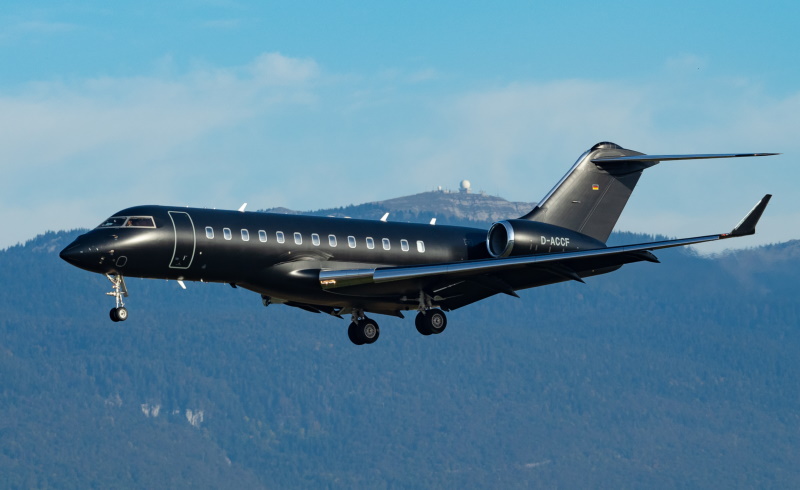
The "Global 6000" -- originally the "Global Express XRS" -- in contrast, was externally like the original Global Express, but with refinements, most notably increased range. It featured a new fuel tank in the wing-body fairing, as well as a rapid refueling capability; a modification to the flap system to permit shorter take-offs; two more windows, and more storage space; and standard fit of the "Bombardier Enhanced Vision System (BEVS)" HUD. It was otherwise similar to the original Global Express. The Global 6000 was announced in 2003, with initial flight of the first prototype on 16 January 2005. The Global 6000 entered service in 2005, to replace the original Global Express in production.
A "Global 7000" -- later changed to "Global 7500", after redesign improved its range -- was announced in 2010, this variant featuring a fuselage stretch of 3.43 meters (11 feet 3 inches) relative to the Global 6000, plus a new transonic wing, fly-by-wire flight controls, and substantial use of lightweight aluminum-lithium alloys. It was powered by GE Passport 20 turbofans with 73 kN (7,482 kgp / 16,500 lbf) thrust, plus 8% better fuel efficiency than the Global 6000. Range was 14,250 kilometers (8850 miles / 7700 NMI).
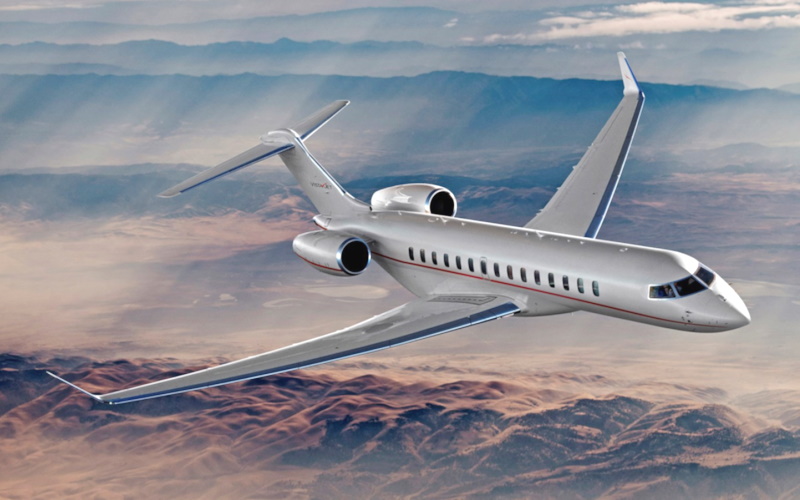
Four flight prototypes and a ground-test airframe were built, with initial flight of the first prototype on 4 November 2016. Certification was in 2018, with initial deliveries late in the year. The Global 7500 is being followed by the "Global 8000", which is a 7500 with reduced cabin space and more fuel, giving it a range of 14,800 kilometers (9200 miles / 8000 NMI). It will be introduced in 2025.
Two new variants, the "Global 5500" and "Global 6500", were announced in 2018. They were of course updates of the Global 5000 and Global 6000, featuring:
The two aircraft had high subsonic performance, in large part due to the new wing. The Global 5500 had a range of 10,925 kilometers (6,785 miles / 5,900 NMI), giving it the ability to link Sao Paulo to Paris, or Moscow to Los Angeles; while the Global 6500 will have a range of 12,225 kilometers (7,595 miles / 6,600 NMI), allowing it to connect Hong Kong or Singapore to London. One Global 5000 and two Global 6000s were modified as prototypes. Certification was in 2019, with customer deliveries following in 2020.
BACK_TO_TOP* The Bombardier Global series has been enthusiastically embraced as a military platform. The history of the Global in military service began in the spring of 1999, when Raytheon was awarded the contract in the $1.3 billion USD "Airborne Stand Off Radar (ASTOR)" competition for the UK. The ASTOR program was intended to develop a surveillance aircraft carrying air-to-ground radar for battlefield surveillance.
ASTOR was a joint program of the British Army and Royal Air Force (RAF). The program had its origins in the 1980s in the form of the "Corps Airborne Standoff Radar (CASTOR)" requirement for the British Army, which wanted to obtain the capability to observe Soviet military movements in Central Europe. The fall of the Soviet Union threw CASTOR into confusion, but the US Joint-STARS radar platform, based on the Boeing 707 jetliner, proved very useful during the Gulf War in 1991; the British were impressed, leading to the issue of the ASTOR requirement in the mid-1990s.
The UK obtained five ASTOR systems based on modified Global Express airframes, along with two portable ground sites and six tactical ground stations mounted on trucks. The primary payload was a "synthetic aperture radar (SAR)" system based on the Hughes "Advanced SAR Radar Type 2 (ASARS-2)" radar system, used on the US Air Force U-2 reconnaissance aircraft. The ASTOR had a set of radio datalinks to allow it to interact with ground stations. The aircraft could operate at altitudes of 15,250 meters (50,000 feet) or higher for 11 hours. Initial plans to add inflight refueling capability were canceled. The aircraft had two pilots and three electronics system officers, and additional seats and bunks for relief crews.
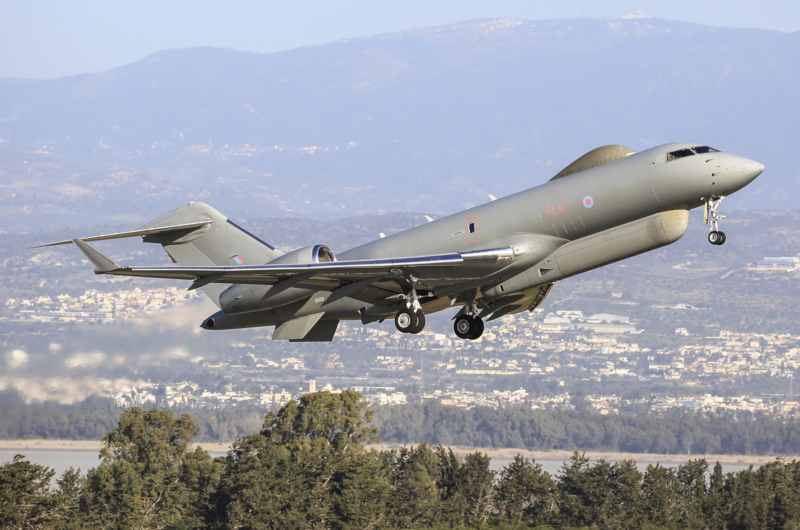
A Global Express was fitted with equipment fairings for aerodynamic tests, performing its initial flight in this configuration in 2001. An operational prototype with a full gear fit was flown in 2004 and delivered to the UK for service trials, with the type being accepted into service in late 2008 and promptly sent off to Afghanistan. In RAF service, the ASTOR was given the designation of "Sentinel Reconnaissance Mark 1" or just "Sentinel R1".
Due to UK budget shortfalls, the decision was made to axe the Sentinel fleet after its return from Afghanistan, with the aircraft to remain in service until they could be replaced by a cheaper alternative. However, the Sentinels also proved useful in the Anglo-French intervention in Mali in 2013, with the RAF requesting that the cancellation of the program be reconsidered. However, the ASTOR fleet was finally retired in the spring of 2021. Exactly what will replace them is unclear.
* The US Air Force has also obtained the Global for battlefield operations, as a flying communications platform designated the "E-11A Battlefield Airborne Communications Node (BACN)". The E-11A was built to obtain communications from a wide variety of different radio systems, and performed relay and translation among them. Four E-11As were acquired, the first being based on a Global 5000 and going into service from 2010, the other three being Global 6000 machines, with final delivery in 2013.
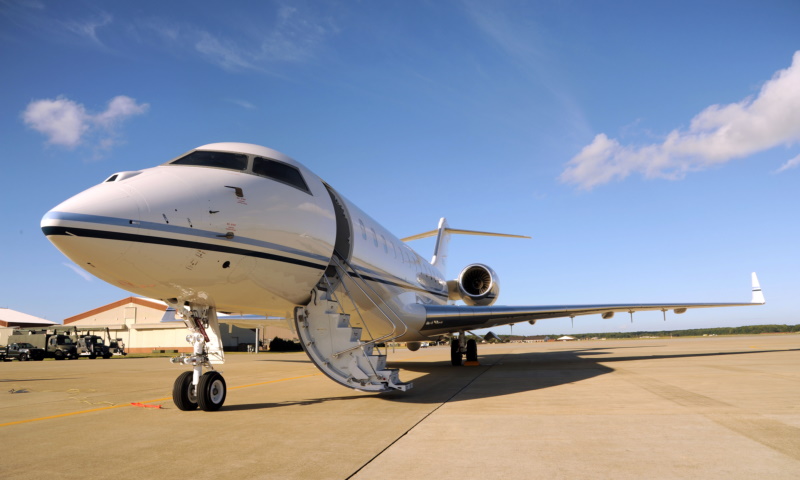
Three of them looked much like stock Globals, except for a litter of small antennas -- but one was kitted up with a top dome and a ventral canoe, like the Sentinel R.1, suggesting it was a surveillance platform, as well as a BACN relay. One was lost in a crash in Afghanistan in 2020. The Air Force plans to acquire six more E-11As. In service, the crewed E-11A is complemented by the "EQ-4B BACN" version of the Northrop Grumman Global Hawk drone, with the E-11A performing fast-reaction missions while the EQ-4B takes on endurance missions.
SAAB has sold five "GlobalEye" radar surveillance platforms, based on the Global 6000, to the United Arab Emirates, with the first delivered in 2018. They featured:
The combination of Seaspray and Erieye radar was unusual, clearly indicating that the GlobalEye was intended to provide both air and surface surveillance. The aircraft had five workstations, plus a forward rest area. In 2021, the Swedish government announced that at least two GlobalEyes would be obtained for the Flygvapnet, the Swedish Air Force, replacing SAAB 340 Erieye machines.
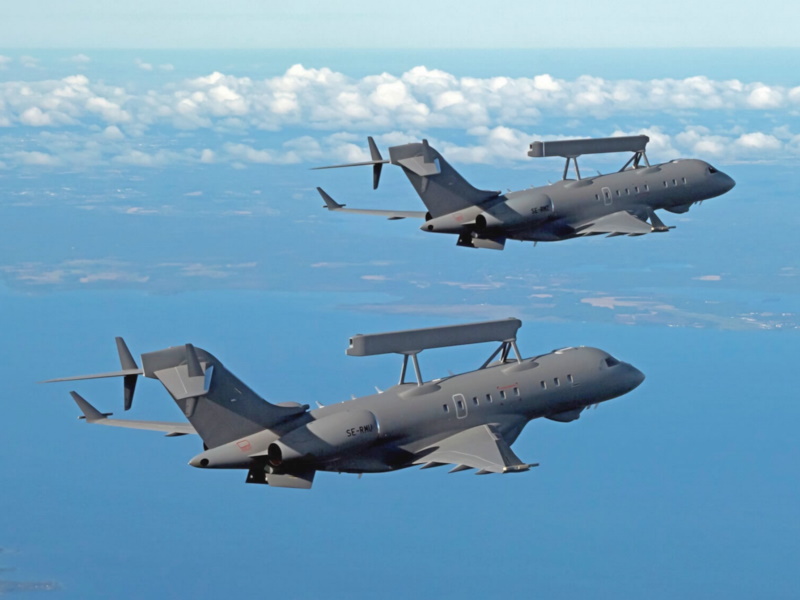
The UAE has also obtained two Global 6000s kitted up for signals intelligence under the "Dolphin" program, with Marshalls of Cambridge UK doing the update, but the details are secret. Images show them to have a ventral canoe fairing and a litter of antennas. Turkish Aerospace Industries is similarly converting four Global 6000s to "Hava SOJ (stand-off jammer)" configuration. In 2020, Germany decided to acquire three Global 6000s as signals intelligence (SIGINT) platforms, following an attempt to obtain four MQ-4C Triton drones -- the Triton being a naval version of the Global Hawk -- that fell through. Specifics of the Global buy hadn't been announced at last notice.
As a complement to the GlobalEye, SAAB is developing a maritime patrol variant of the Global 6000, the "Swordfish", with similar kit, except with the Erieye radar deleted, and antisubmarine warfare kit added, including a magnetic anomaly detector tailboom and a sonar buoy dispenser. It also has two stores pylons under each wing, with the capability of hauling offensive stores such as antiship missiles, plus an internal weapons bay, presumably for homing torpedoes.
In 2015, Israel Aircraft Industries (IAI) announced its own maritime patrol aircraft, the "ELI-3360", based on the Global 5000. As offered, it was fitted with:
The German Luftwaffe is obtaining three "Pegasus" SIGINT aircraft based on the Global 6000. They will be fitted with the Hensoldt Kalaetron Integral SIGINT system and delivered in 2026:2028.
As mentioned earlier, the US Army flew two Challenger 605s as ARTEMIS testbeds for a future HADES surveillance platform. The Army then flew a more sophisticated "Airborne Reconnaissance and Electronic Warfare System (ARES)" based on a contractor-owned Global 6000.
The service now wants to obtain an "Army Theater Level High Altitude Expeditionary Next Airborne ISR Radar (ATHENA-R)" platform as a stopgap towards HADES, using contractor-owned and operated aircraft. No award has been made at last notice, but some of the offerings are based on the Global 6500.
BACK_TO_TOP* After the introduction of the Challenger 600, its wide fuselage suggested to Canadair officials that it would be straightforward to stretch the aircraft to provide more seats, and there was a plan for a "Challenger 610E", which would have had seating for 24 passengers. It didn't happen, the effort being canceled in 1981 -- but the idea didn't go away, either.
In 1987, studies began for a much more ambitious stretched configuration, leading to the formal launch of the "Canadair Regional Jet (CRJ)" program in the spring of 1989. The "Canadair" name was retained despite the fact that Bombardier had bought out the company. The first of three development machines for the initial "CRJ-100" performed its first flight on 10 May 1991, though one of the prototypes was lost in a spin mishap in July 1993. The type obtained certification in late 1992, with initial delivery to customers late in that year.
The CRJ-100 was stretched 5.92 meters (19 feet 5 inches), with fuselage plugs fore and aft of the wings, and featured two more emergency exit doors, plus a reinforced and modified wing with extended span. Typical seating was 50 passengers, the maximum load being 52 passengers. The CRJ-100 also featured a Collins ProLine 4 avionics suite, Collins weather radar, GE CF34-3A1 turbofans with 41.0 kN (4,180 kgp / 9,220 lbf), more fuel capacity, and of course improved landing gear to handle the higher weights. It was followed by the "CRJ-100ER" subvariant with 20% more range, and the "CRJ-100LR" subvariant with 40% more range than the standard CRJ-100.
The CRJ-100 series was then replaced in production by the "CRJ-200", which was much the same, except for fit of GE CF34-3B1 turbofans, with identical thrust levels to the CF34-3A1, but improved fuel consumption. Initial deliveries were in 1996. Of course, "CRJ-200ER" and "CRJ-200LR" longer-ranged variants were introduced, as was a business jet variant, somewhat confusingly known as the "Challenger 800", later refined into the "Challenger 850".
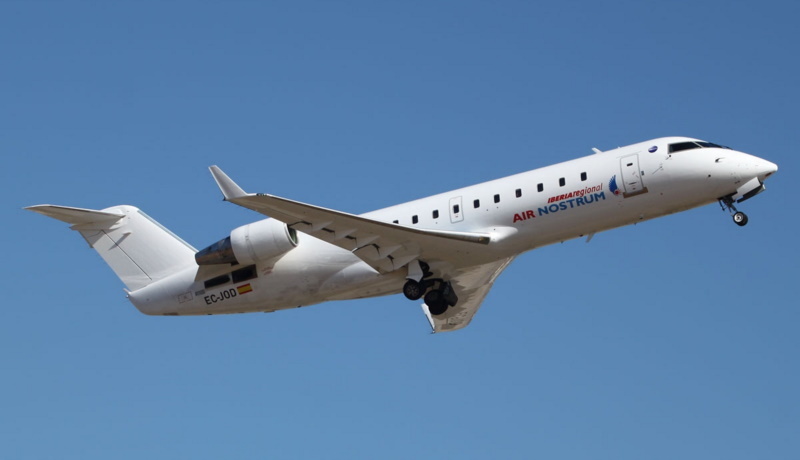
In addition, there was an obscure "CRJ-440" variant, which was a CRJ-200 with 44 seats instead of 50, with the deleted rows taken up by a coat closet. It was trickery to sell aircraft to Northwest Airlines; it appears the CRJ-440s were eventually updated back to 50 seats.
___________________________________________________________________
BOMBARDIER CRJ-200ER:
___________________________________________________________________
wingspan:
21.21 meters (69 feet 7 inches)
wing area:
48.35 sq_meters (520.4 sq_feet)
length:
26.77 meters (87 feet 10 inches)
height:
6.22 meters (20 feet 5 inches)
empty weight:
13,740 kilograms (30,290 pounds)
MTO weight:
23,135 kilograms (51,000 pounds)
max cruise speed:
860 KPH (535 MPH / 465 KT)
service ceiling:
12,500 meters (41,000 feet)
take-off field length:
1,525 meters (5,010 feet)
range:
3,045 kilometers (2,645 MI / 1,645 NMI)
___________________________________________________________________
* Over 400 CRJ-100/200 machines had been delivered by the end of the century. By that time, a further stretched variant with a capacity of 70 passengers, the "CRJ-700", was in advanced development.
Preliminary investigation for the 70-passenger CRJ-700 began in 1995, with formal program launch in 1997. Flight of the initial development machine was on 27 May 1999, with Craig Tylski and Chuck Ellis at the controls. Certification was in late 2000, with initial customer deliveries in 2001.
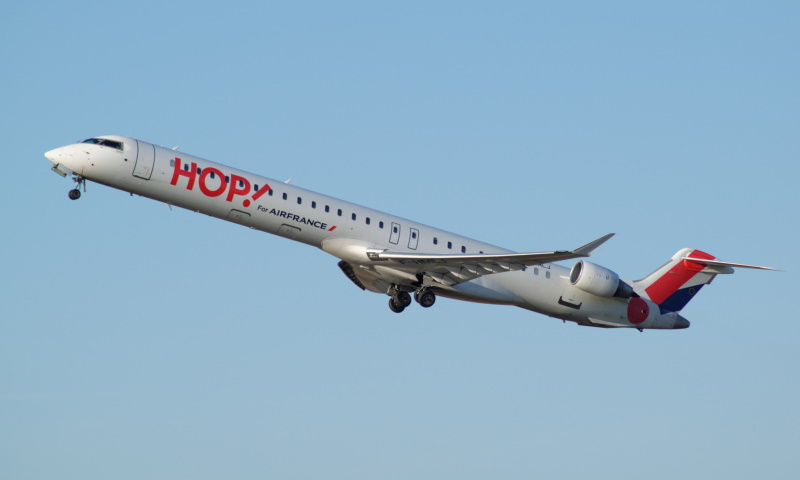
As introduced, the CRJ-700 was powered by twin CF34-8C1 turbofans with 56.4 kN (5,745 kgp / 12,670 lbf) thrust each and full authority digital engine controls (FADEC). It featured a new wing with an increased wingspan, plus a wider tailplane and as a roomier interior with a lower floor. While the usual seating arrangement was for 70 passengers, arrangements for 72 or 78 passengers were possible as well. The cockpit was fitted with a Rockwell Collins Pro Line 4 avionics system with six displays. The product line also included the increased-range "CRJ-700ER" and the "CRJ-700LR". A 75-seat "CRJ-705" with an improved interior was introduced in 2005; only a small number were built.
___________________________________________________________________
BOMBARDIER CRJ-700:
___________________________________________________________________
wingspan:
23.24 meters (76 feet 3 inches)
wing area:
70.61 sq_meters (760 sq_feet)
length:
32.51 meters (106 feet 8 inches)
height:
7.57 meters (24 feet 10 inches)
empty weight:
19,595 kilograms (43,200 pounds)
MTO weight:
32,885 kilograms (72,510 pounds)
max cruise speed:
860 KPH (535 MPH / 465 KT)
service ceiling:
12,495 meters (41,000 feet)
take-off field length:
1,565 meters (5,135 feet)
range:
3,150 kilometers (1,135 MI / 1,700 NMI)
___________________________________________________________________
* In 1999, confronted with the introduction of higher-capacity regional jets from competitors, Bombardier began to investigate an all-new aircraft, the "BRJ-X", as well as a further stretch of the CRJ-700 designated the "CRJ-900", with a maximum capacity of 90 passengers. The BRJ-X concept remained in limbo, but Bombardier formally committed to the CRJ-900 in July 2000.
The first prototype, which was a modification of the prototype CRJ-700, performed its first flight on 21 February 2001. It retained the wings, engines, wheels, and brakes of the CRJ-700. The first new-build CRJ-900 performed its initial flight on 20 October 2001. The type obtained certification in 2002 and initial deliveries to customers were in 2003.
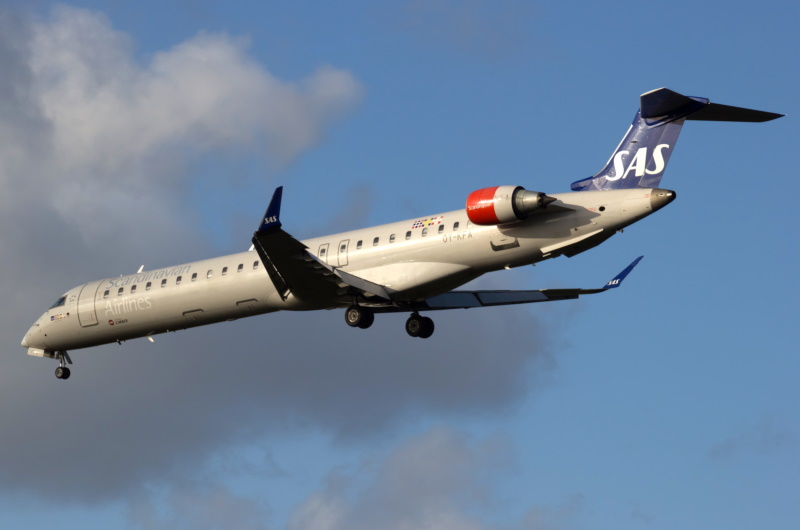
The CRJ-900 couldn't quite carry 90 passengers, there being 86 seats in a high-density configuration. Other configurations included an 80-seat single-class arrangement and a 75-seat two-class arrangement, with 15 seats in business class. The CRJ-900 was powered by twin GE CF34-8C5 turbofans with a normal take-off thrust of 58.4 kN (5,950 kgp / 13,125 lbf), and featured a stronger wing plus more robust landing gear. New overwing exits were added on each side. Both ER and LR variants were introduced.
___________________________________________________________________
BOMBARDIER CRJ-900:
___________________________________________________________________
wingspan:
24.85 meters (81 feet 6 inches)
wing area:
70.61 sq_meters (760 sq_feet)
length:
36.40 meters (119 feet 4 inches)
height:
7.51 meters (24 feet 7 inches)
empty weight:
21,545 kilograms (47,505 pounds)
MTO weight:
36,514 kilograms (80,500 pounds)
max cruise speed:
880 KPH (550 MPH / 475 KT)
service ceiling:
12,495 meters (41,000 feet)
take-off field length:
1,875 meters (6,145 feet)
range:
2,955 kilometers (1,555 MI / 1,350 NMI)
___________________________________________________________________
The CRJ-190 was followed by the 100-seat "CRJ-1000", which had a fuselage stretch of 3 meters (10 feet). It retained the same engines as the CRJ-900 and had about 90% parts commonality, with a maximum take-off weight of 41,630 kilograms (91,800 pounds) and a range of 3,130 kilometers (1,945 miles / 1,690 NMI). It had larger overhead storage bins and windows, as requested by customers. Initial flight was in the summer of 2008, with certification and initial customer deliveries in late 2010.
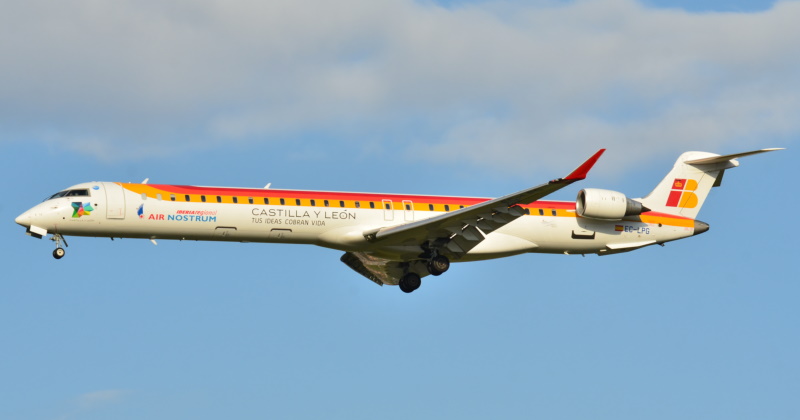
From 2007, the CRJ family was enhanced in production to the "NextGen" standard, with tweaks for improved flight efficiency and refinements in cabin layout. A redesigned "Atmosphere" cabin layout was introduced in 2018, along with avionics updates. The ultimate addition to the family was the "CRJ-550", announced in 2019 -- which was essentially an up-to-date CRJ-700 with a three-class, 50-seat layout. Deliveries were late in 2019.
However, as far as Bombardier was concerned, the CRJ-550 was the end of the line. The CRJ series ended up being unprofitable, and so the product line was sold off to Mitsubishi Heavy Industries of Japan in 2019. Bombardier finished existing backlog and then ended production, at a total of about 2,000 aircraft. Mitsubishi apparently wants to perform fleet support and maintenance, having demonstrated no interest in manufacturing the CRJ.
BACK_TO_TOP* In the face of climate change and rising fuel costs, aircraft manufacturers have been working on highly-efficient aircraft designs. Bombardier calls its offering "EcoJet", which the company says will cut emissions in half. It's a "blended wing-body (BWB)" aircraft, which is a popular configuration for energy-efficient aircraft.
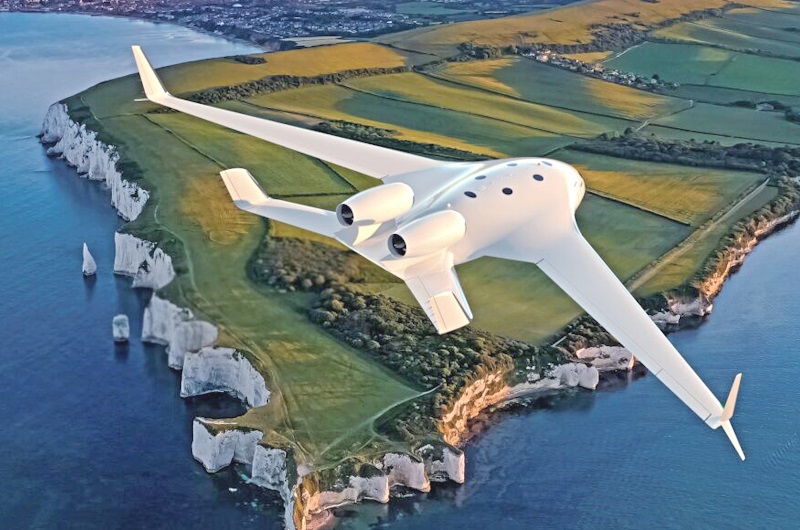
Bombardier has flown 7%-scale and 15%-scale demonstrator models. While many BWB aircraft are effectively flying wings, the EcoJet has distinct wings and fuselage, just blended together. The wings are swept with vee-style winglets, the tailplane is swept with fins at the ends, with twin fan engines mounted above the tailplane. Nothing much has been nailed down yet; no particular propulsion option has been selected, and there's no schedule for a full-size flight prototype.
* Sources include:
I obtained much of the stats off the Bombardier website. I originally picked up some materials off the general Web, thinking I could render them down to speed up writing this document, but the result was the opposite. The web materials were littered with careless errors, and I had to go over the stats carefully to weed them out.
* Illustration credits:
* Revision history:
v1.0.0 / 01 jun 06 v1.0.1 / 01 mar 08 / Review & polish. v1.0.2 / 01 feb 10 / Review & polish. v1.1.0 / 01 jan 12 / Added section on ASTOR & military variants. v1.2.0 / 01 dec 13 / BACN comments, CS100 first flight, Boeing MSA. v1.3.0 / 01 nov 15 / Challenger 350 & 650, GX 7000 & 8000, ELI-3360, etc. v2.0.0 / 01 oct 17 / Reorganization. v3.0.0 / 01 sep 19 / Jetliner divestment, GlobalEye, Swordfish. v4.0.0 / 01 sep 21 / General clean-up. v4.1.0 / 01 sep 23 / Review, update, & polish. (*)BACK_TO_TOP
